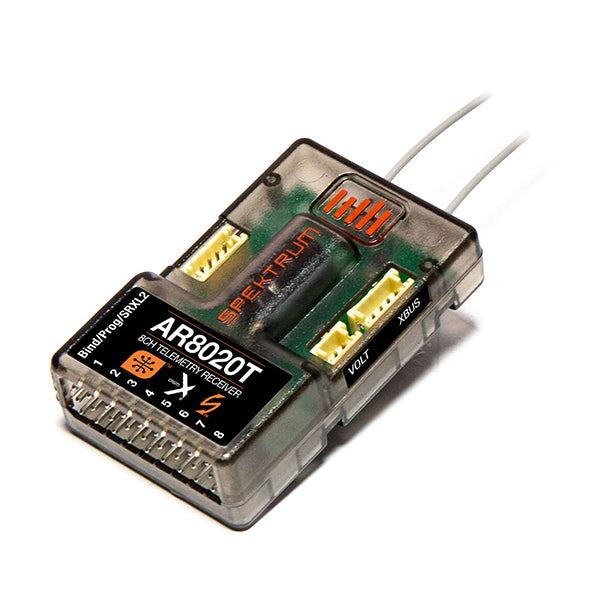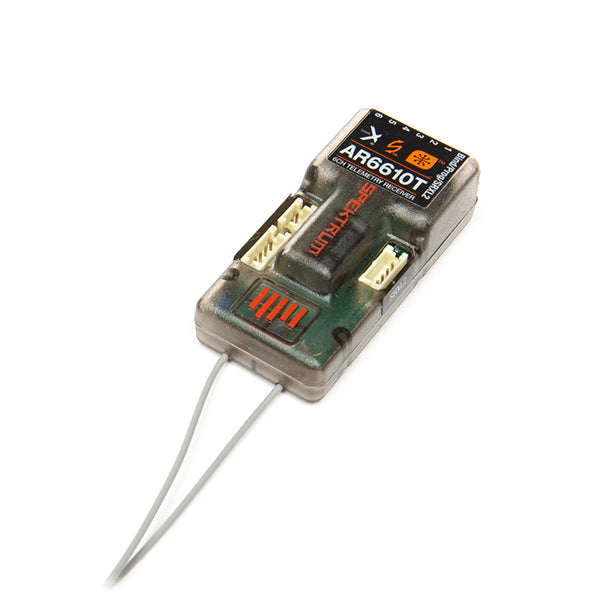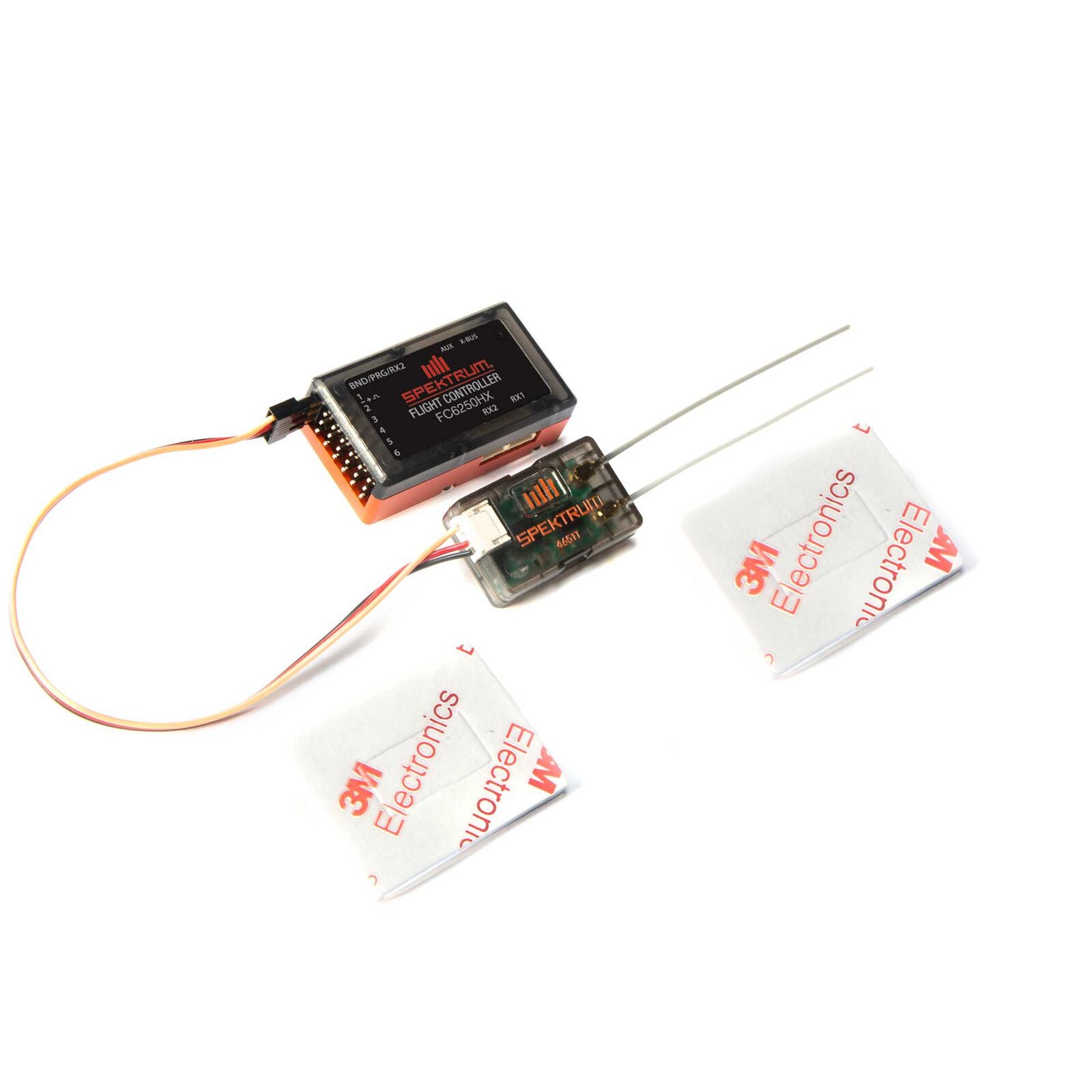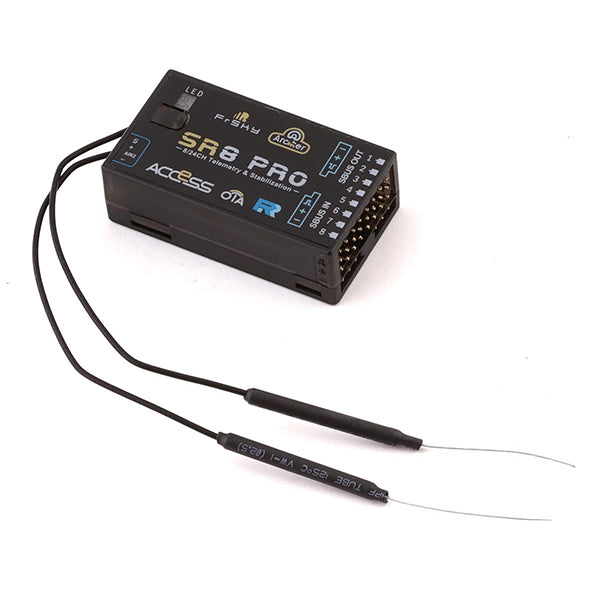What Does An RC Plane Receiver Do?
As its name implies, an RC plane receiver receives signals from the transmitter and sends them to the servos and other electronic components in the plane. It's the most important part of an RC plane, and without it, flying would be impossible as they are in charge of executing simple commands or complex aerobatic tricks.
Key Features of RC Plane Receivers
Here are some key features of RC receivers:
-
Channels: In an RC receiver, channels determine the plane's functionality, and so the number of channels on an RC plane receiver determines how many functions it can control. For instance, a 6-channel receiver like the Spektrum RC AR631 6-Channel AS3X & SAFE Receiver can perform six functions, like managing the throttle, rudder, elevator, ailerons, flaps, and landing gear. Essentially, more channels mean more control over different aspects of your plane.
-
Modulation: Modulation, in RC receivers, is used to refine signal transmissions between the transmitter and receiver, and it can be DSMX or DSM2. Spektrum receivers, like the Spektrum RC AR8360T DSMX 8-Channel AS3X & SAFE Telemetry Receiver, for instance, often use DSMX modulation, which offers less interference and more reliable control compared to older modulation techniques.
-
Smart Technology and Programming: Modern receivers come with smart technology features that allow for easier programming and enhanced functionality. These programmable receivers can be fine-tuned to match your specific needs, making them ideal for both beginners and advanced pilots.
-
Safety Features: For RC plane receivers, SAFE (Sensor Assisted Flight Envelope) technology keeps the plane stable and under control, especially during critical phases like takeoff and landing. This technology is a lifesaver for new pilots who are still mastering the basics of flying. It helps them fly without the fear of crashing.
-
Telemetry: Some receivers come with telemetry features that provide real-time data about your plane's performance. This information can include battery voltage, signal strength, and temperature, helping you make informed decisions while flying.
Choosing the Best RC Plane Receiver
When it comes to choosing the best RC plane receiver, pilots need to consider certain key factors so they don't make the worst decision of their flying careers. These factors include:
-
Compatibility: Enthusiasts will need to ensure that the selected receiver is compatible with their transmitter.
-
Range: For RC plane receivers, the range is typically how far the plane can receive signals from the receiver. Knowledge of this is important, or else the plane loses signal and crashes. A standard receiver might offer a range of several hundred meters, while more advanced models can handle much greater distances. If you love flying over large distances, you should stick with the advanced receivers.
-
Number of Channels: Before you purchase that receiver, determine the number of channels you need based on your plane's complexity. A simple park flyer might only need four channels, while a more complex model could require six or more.
-
Size and Weight: The receiver should be lightweight and compact to fit easily into your plane without affecting its balance and performance.
-
Price: Prices for receivers can vary widely, so set a budget and look for the best options within your range. Higher-end models will offer more features, but there are plenty of affordable options that still provide excellent performance.
-
Brands: Stick to reputable brands like Spektrum, Futaba, and FrSky, which are known for their quality and reliability.
Best RC Plane Receivers On The Market
With so many receiver options from countless brands, we've narrowed down the most popular and efficient RC plane receivers on the market. These options can be found exclusively on RC Visions, and they include the following:
The Spektrum RC AR631 6-Channel AS3X SAFE Receiver is a powerhouse. This receiver offers unmatched stability and precision with its integrated AS3X (Artificial Stabilization – 3-aXis) technology. This means smoother flights and more precise control, even in windy conditions. But the AR631 doesn't stop there. It also features SAFE (Sensor Assisted Flight Envelope) technology, which acts as an invisible co-pilot. This feature can help stabilize your plane and prevent crashes, making it an excellent choice for beginners and experienced pilots alike.
The AR631 has a 6-channel capability, which allows for extensive control options, from basic flight functions to more advanced features like retractable landing gear and flaps. Setting up this receiver is a breeze as it seamlessly integrates with a range of Spektrum transmitters. So, if you're looking for a receiver that offers both advanced features and user-friendly operation, the AR631 is an excellent pick.
This receiver takes it up a notch with its 8-channel capacity and built-in telemetry capabilities, offering real-time data about the aircraft's performance, battery voltage, signal strength, and more. The AR8360T also features the same AS3X and SAFE technologies found in the AR631, providing exceptional stability and safety. With eight channels at your disposal, pilots can control a variety of functions and accessories, making this receiver perfect for advanced pilots.
Although not a plane receiver, Spektrum's Wireless Simulator USB Dongle is the best choice for beginners. This little gadget is a game-changer for pilots who need to develop their flying skills without risking their aircraft. This device plugs into your computer and connects wirelessly to your RC transmitter, giving you the chance to practice on various flight simulators. It's perfect for rainy days or when you just want to try out new tricks and maneuvers in a safe, virtual environment.
Installation and Setup Tips
Now that you've gotten the RC plane receiver of your choice, some installation tips are due. Here are some pointers to ensure a smooth setup:
-
Mounting: For successful mounting, secure the receiver in a location that minimizes exposure to vibrations and potential damage. Use a double-sided tape or Velcro to keep it in place.
-
Antenna Placement: Position the antennas at 90-degree angles to each other to maximize signal reception. Avoid placing them near metal components or other sources of interference.
-
Range Check: Before your first flight, perform a range check to ensure the receiver is functioning correctly. This involves walking a certain distance away from your plane while checking for signal loss.
-
Binding: Bind the receiver to your transmitter according to the manufacturer's instructions. This process ensures that the receiver recognizes and responds to signals from your specific transmitter.
-
Firmware Updates: Keep your receiver's firmware up to date to benefit from the latest features and improvements. Check the manufacturer's website regularly for updates.
The Bottom Line
Investing in a quality receiver ensures that your RC plane remains responsive and reliable, allowing you to focus on the thrill of flying. Whether you're a beginner looking for a simple setup or an advanced pilot seeking the latest technology, RC Visions has the best RC plane receiver for you. So, gear up, refine your choice, and get ready to conquer new heights!























